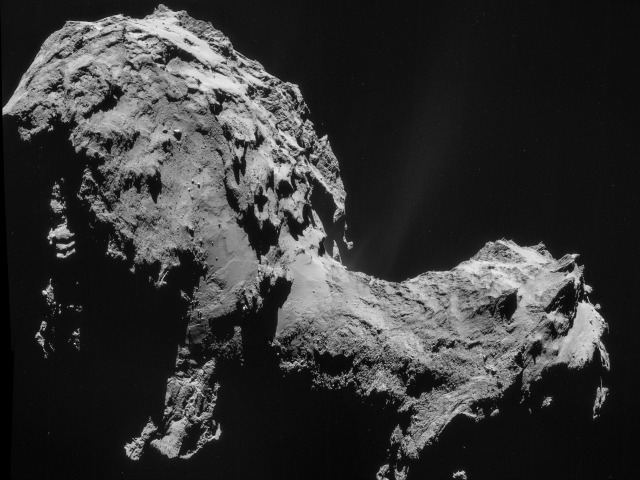The green agenda has claimed a new victim: the Philae comet probe. As the probe lies dormant, unable to recharge its solar powered batteries so far from the sun, it has emerged that green lobbyists were behind moves to bar rocket scientists from using nuclear energy to power the device forcing scientists to rely on solar power instead.
The European Space Agency opened a new chapter in space exploration last week when it successfully landed the Philae probe on the surface of the comet Churyumov-Gerasimenko, currently hurtling through space at nearly 40,000 miles an hour, at a cost of £1billion. But less than three days later the chapter closed as the batteries on Philae died.
Philae, and the spacecraft which transported it, known as Rosetta, are both wholly solar powered thanks to fears surrounding the safety of nuclear powered devices being launched into space stoked up by anti-nuclear campaigners. Rosetta, which launched in 2004 and has been travelling through space for the last decade powered only by the sun’s rays, is the first solar powered vehicle to travel so far from the sun.
Journalism professor Karl Grossman, writing for the Ecologist back in August when Rosetta first rendezvoused with the comet, called the mission “a demonstration that in space as on Earth, solar power is an alternative to dangerous nuclear power”.
He describes in his article how two accidents, one in 1964 and another in 1978, in which satellites launched by America and Russia fell back to earth, caused radioactive material to be spread across large parts of the globe, and cites one scientist, Dr. John Gofman, professor of medical physics at the University of California at Berkeley, who blamed the latter incident for a “global increase in lung cancer.”
These incidents persuaded anti-nuclear campaigners to target the use of nuclear energy in space missions, and in 1992 the Global Action Against Weapons and Nuclear Power in Space (abbreviated to GN) was set up, with the aim of building an “international citizens movement”. It worked – there are now 150 groups worldwide associated with GN who campaign regularly. What Grossman doesn’t say is that he was instrumental in setting up GN.
GN, and other associated groups, have a long history of attempting to thwart nuclear powered space exploration. When the Galileo Project which launched in 1989 was announced, anti-nuclear campaigners protested every step of the way. Michael Meltzer, in his book Mission to Jupiter: a History of the Galileo Project recounts that “The Florida Coalition for Peace and Justice [also behind GN] began a 200-mile “peace walk” from Cape Canaveral, Florida, to Kings Bay, Georgia, to protest both the Galileo and the Trident missiles, which were flight-tested in Kings Bay. The Florida group also planned to enter Kennedy Space Center and sit on Galileo’s launchpad in order to block the launch.”
Legal challenges against Galileo were launched by the groups, but in court NASA officials gave sworn testimony that nuclear energy was the only option available to them. More recently, the activists campaigns have attracted the attention of current affairs program 60 Minutes, and they continue to organise regular campaign days and conference weeks.
Still NASA held out – until in 2011 when the Juno mission to Jupiter, due to arrive at the planet in 2016, was launched. It is solar powered. Grossman and his activist friends are clearly jubilant regarding their success in persuading space exploration to go green.
Thanks to its purely solar capability, the Philae probe was originally intended to land on an open plain on the comet’s surface nearly 370million miles from the sun. At that distance the sun is small and very weak, so the probe needed to harvest all the light it could access in order to keep its batteries charged. But problems on landing meant that the probe finally came to rest some half a mile away from the designated spot, in a rocky, shady area. In that position, it only has access to sunlight for 1.5 hours in every 12.4 hour comet rotation, not nearly enough to power the batteries.
On the 15th November, three days after the landing, a scientist working on the Rosetta mission, which flew the probe to the comet, took to the mission’s blog site to write “On board Philae, system voltage has fallen very close to 21.5V; below that, the battery won’t last much longer. At this time, there is insufficient sunlight to provide power.”
Just 64 hours after touching down the batteries finally gave out, rendering the probe useless. Scientists are now talking of it being ‘in hibernation’ until the comet comes closer to the sun, at which point they hope its systems can gather enough energy to turn itself back on.
With its batteries depleted and not enough sunlight available to recharge, Philae has fallen into ‘idle mode’ for a potentially long silence. In this mode, all instruments and most systems on board have shut down.
“Prior to falling silent, the lander was able to transmit all science data gathered during the First Science Sequence,” said Stephan Ulamec, the Lander Manager “This machine performed magnificently under tough conditions, and we can be fully proud of the incredible scientific success Philae has delivered.”

COMMENTS
Please let us know if you're having issues with commenting.